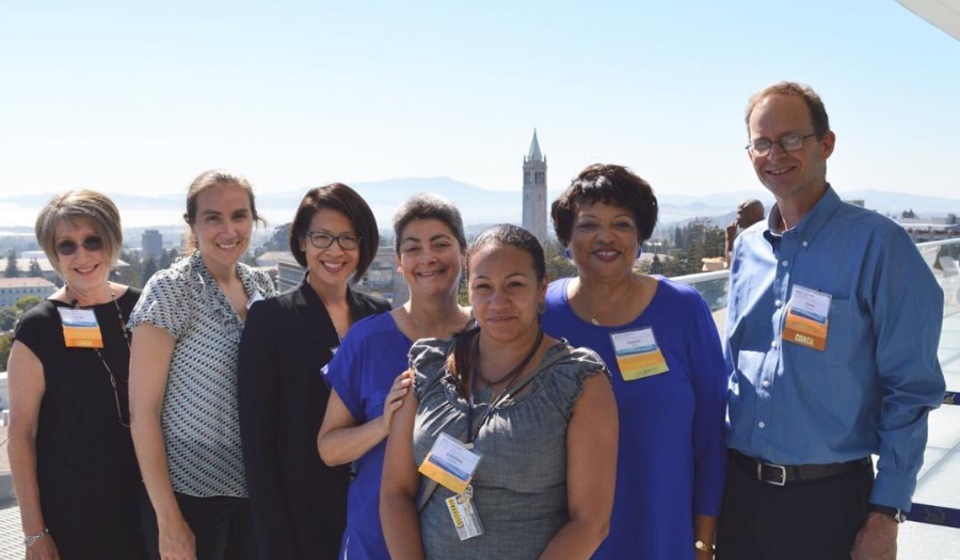How do you determine a need for change and make a case for it?
I set the stage for thinking about change by focusing on the University's research, teaching and public service mission. My teams help Berkeley employ technology to do things more easily, cheaply, and effectively. Understanding the University strategic plan and our financial picture helps guide and prioritize our change efforts. The Reimagining IT program engages everyone inclusively in helping to identify and participate in our initiatives. Changes at the University reflect broader changes in technology and education that are in rapid flux, so I spend a lot of time reading, and networking with people at other universities and in industry to learn from them.
While sometimes the need for change stems from an outdated system or capabilities of a new technology, it is usually driven by a new law or policy, a new academic program, or change demanded by students or faculty. I ask a lot of questions and gather data. To make a business case it's important to assess the demand - how many users will be impacted? Is the change worth the disruption? What's the cost/benefit and will it bring a return on investment?
In proposing a digital workflow system to the CFO, the team calculated how much physical space we could free up for campus by digitizing vast stores of records. That was great cost savings that we knew would also aid the University's space challenges- before we even got to the efficiencies the digital processes would enable.
You led quite a few changes on this campus (i.e. bmail, Box, Google, etc.). What challenges did you encounter, and how did you overcome them?
A major focus for IT is standardizing and simplifying wherever possible, while keeping the University's mission in focus. One of my first large projects involved moving Berkeley's Peoplesoft HR system off the mainframe. One challenge we discovered in testing was a vendor product that didn't work as advertised, so we had to charter a second project to address that while the first project was in-flight. Mid-implementation changes in sponsorship, budgets, leadership, or product capability are the most challenging to mitigate. At this stage of the project, known as the "trough of despair", many people thought we would fail, but the team persevered and finished in just over six months.
As we've expanded our use of automation tools and better IT service management, our IT operations work has become more stable and predictable. Change disrupts people's work and can introduce fissures between stakeholders. We help mitigate this with change management. In the email and calendar cloud migration project, we needed to standardize on one vendor. We used a transparent process of analysis and decision-making with stakeholders at Berkeley. The managers on our team engaged deeply with those most impacted by the decision - administrative assistants. To mitigate their work disruption, we held a series of workshops so they could critique the new system and give input before the launch. Although other universities' experiences had been rough, when we went live our users had no surprises. This type of work, collaboration between change managers, developers, analysts, vendors and clients, doesn't usually make it into a launch announcement, but helps ensure long-term success.
What do you think are the crucial components to effectively manage change?
Having the right team is essential. Strong executive sponsorship is important, but we cannot always get executive attention on every important initiative. So for many initiatives we assemble a sponsoring consortium to fund and govern the service. This work requires operating across many organizational silos, both inside and outside of the IT organization. I'm an advocate of small, agile teams that make a disproportionate positive effect relative to their size. Much of the work to make a project successful involves smoothing fissures among stakeholders, and the unglamorous negotiating and sled pulling that happens in the background.
Communication is key. With executives and sponsors, it's critical to be clear about what defines success, to know what you need to deliver success, and to be firm, clear and consistent in setting expectations, especially in defining up-front high level timelines and resources needed to make the plan work.
Most of all, success depends on engagement, respect and transparency at all levels. Universities are full of people with very different talents and perspectives, and this diversity is so important for our collective success.
Although the only constant is change, many people don’t like change. How do you create buy-in when folks aren’t interested, or (even worse) are resistant to it?
This is a great question. I like to start by mapping out the stakeholders for every change initiative -- everyone from sponsors to the users of the new (or changed) service. Although it's practically cliche, we know that there will always be some staunch opponents you will never win over, fence-sitters who aren't sure, and the supporters who will be champions. Seek out champions and enlist them as ambassadors. Reach out to fence sitters to see what will win them over - and try to understand the opposition. You can learn a lot from resisters, because they often have critical information or insights that can make or break your rollout. So pay attention to them even when you can't win them over fully. I always assume the best intentions of people, no matter where they are as stakeholders.
Widespread communication is helpful, including in-person town hall type events. You need to get out there and over-communicate. The universal lesson we learn again and again on campus-wide initiatives is that the team always believes they are sending too many messages and reaching out beyond what's needed - while the experience of affected stakeholders in our decentralized university is that it's easy for them to miss the outreach. Invite questions, ask for feedback - and welcome it. Then analyze it to sift through and incorporate the feedback. Questions that may seem "in the weeds" may well make or break your project.
What words of wisdom would you like to share with staff who are interested in leading change at UC Berkeley?
Berkeley has an open, collaborative culture that encourages everyone to "lead from where you are." Take advantage of this! My advice is to take initiative, ask lots of questions, and make proposals. Align your ideas with the mission of the University to foster the widest engagement and the most productive discussions and results. Zero in on your initiative's impact on people. Organizational changes and process changes require the most attention, buy-in and commitment from sponsors. Learn who your stakeholders are and include them in decision-making early on!
If you’d like to advance your career with today’s methods read about the corporate lattice model- here.
Know someone (including yourself!) who has changed jobs at Berkeley? E-mail us at wisdomcafe@berkeley.edu to be featured.












